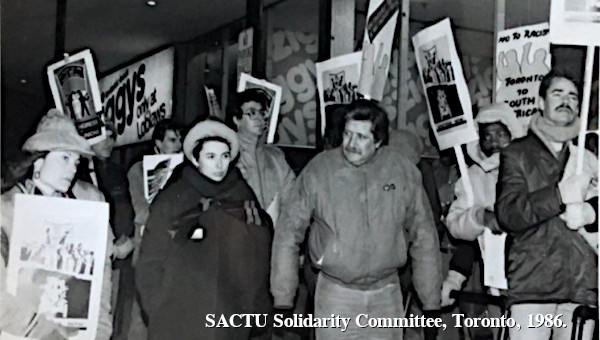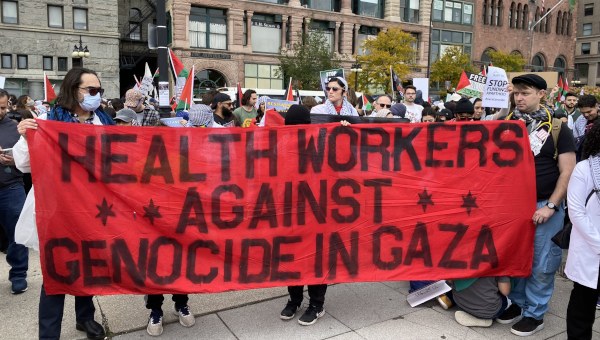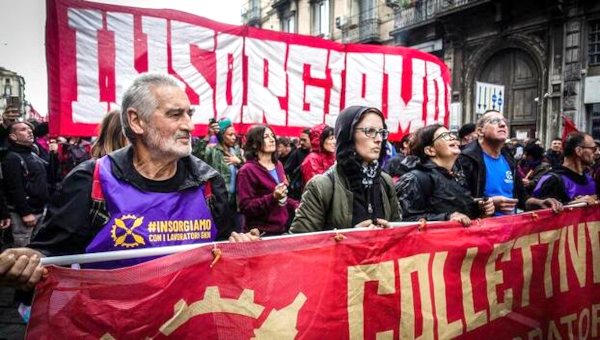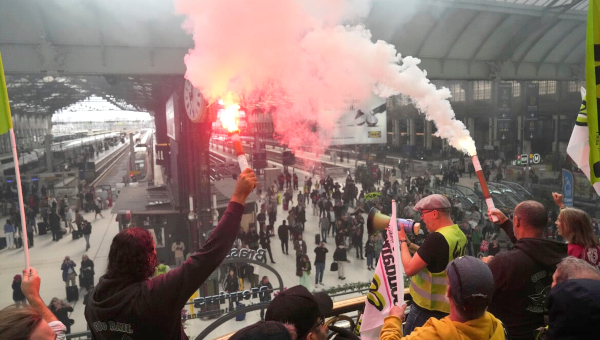To Build Solidarity with Palestine, Labour Movement must look to the past
The South African anti-apartheid movement of the 1970s and 80s serves as a significant source of inspiration for Palestine solidarity activists today. The reasons for this are hardly surprising; the movement was widely successful in pushing for sanctions and divestment at multiple levels of government, in business and across civil society. Less attention, however, is paid to exactly how this movement was so successful, what strategies and tactics it employed, and how these might be adapted by labour activists organizing around Palestine today.
It is worth remembering that opposition to South African apartheid was not a given for Canada’s labour movement. It took dedicated organizing amidst polarizing Cold War attitudes to get union leadership on side. Solidarity, after all, is not something that pre-exists, or can easily be assumed based on abstract principles – it has to be built through the messiness of social and political struggle.
The Canadian anti-apartheid movement provides a wealth of examples for understanding solidarity as a theory and practice shaped by both the global reach of capitalism and structures that opposed it. But there is another reason for re-examining this history. Today, certain segments of Canada’s ruling elite, from university presidents to Bay Street executives, have an unearned reputation as friends of Mandela. Such revisionism overlooks how powerful people were either indifferent to or complicit in the endurance of apartheid.

Organizing From Above and Below
Between March 13 and 19, 1986, over 30,000 Canadian workers embarked on a series of unprecedented labour actions in solidarity with South African workers. Following the call from the African National Congress (ANC) to boycott all South African goods and services, they refused to connect phone calls with South Africa, sell airline tickets bound for South Africa, offload ships with South African goods aboard, and deliver mail with South African addresses.
The week of action was organized by the SACTU Solidarity Committee (SSC), a group that had been actively organizing among Canadian workers since the early 1980s. The actions involved years of organizing among union members and were officially sanctioned by labour leadership who promised to defend any member disciplined for their actions. Jean-Claude Parrot, then president of the Canadian Union of Postal Workers, personally blocked delivery trucks entering the South African embassy in Ottawa.
How was it that a small group of Toronto-based activist were able to coordinate a cross-Canada boycott of South African goods and services and do so with the support of Canada’s labour leadership?
SACTU, or the South African Congress of Trade Unions, was a national trade union federation formed in 1955. It was closely allied with the ANC and the South African Communist Party and advocated for both economic and political rights for South African workers. By the mid-1960s many of its leaders had been banned or exiled, and it operated clandestinely from offices in London and Lusaka while maintaining connections with underground union structures inside the country. SACTU was formally affiliated with the World Federation of Trade Unions (WFTU), composed largely of trade unions from Soviet and non-aligned nations. During the 1970s and 80s it worked to build support among Western trade unions in Europe and North America.
The SACTU Solidarity Committee emerged from the campus based anti-apartheid movement of the late 1970s, specifically the Free Southern Africa Committee in Edmonton. Two student activists, Ken Luckhardt and Brenda Wall, came into contact with SACTU exile leaders in Canada and through them they worked directly with SACTU leadership in London. They were tasked with recording an oral history of the union and writing its history. The resulting book, Organize or Starve: A History of the South African Congress of Trade Unions, was among the first histories of South Africa’s labour movement. Inside South Africa. It was banned and had to be smuggled into the country disguised as a bible.
After returning to Canada, Luckhardt and Wall were given a mandate by SACTU’s leadership to start a solidarity group that could make inroads with Canadian unions. The committee began organizing in Ontario in 1980, producing a regular newsletter and contacting sympathetic union activists and leaders. One of the first challenges they faced was convincing Canadian unions to support SACTU. The major unions, if they thought about international issues at all, largely followed the Canadian Labour Congress (CLC), which was hostile to any communist-aligned unions.
The situation in South Africa was headline news during this period. Internally the struggle was intensifying, and Canadian unions expressed interest in education around South African labour issues. By 1982, the committee had completed a series of cross-Canada tours with SACTU leaders, speaking to smelter workers in Kitimat and public sector workers in Québec. The tours served a dual purpose. They communicated the issues facing South African workers to the Canadian public, and they legitimized the group among Canada’s labour leadership.
This work allowed them to secure meetings with influential union leaders, including Bob White, the Canadian leader of the United Auto Workers (UAW) and Jean-Claude Parrot of the Canadian Union of Postal Workers (CUPW). Jane Armstrong, one of the committee’s core members, remembers that the support of White and Parrot was critical to the early success of the committee. “It meant that through their approval we got access to the locals, and through them we branched out and started our educational work.” With leadership’s backing they were invited to attend local meetings across southern Ontario, and later across the country. Through this they built a roster of local activists to distribute newsletters and educational materials and fundraise for the SACTU strike fund, to which Canadian workers ultimately donated over $250,000.
The committee’s initial success was due to a number of factors. First was their ability to have a core group of organizers working full-time on organizing and education campaigns. One of the committee’s key members, Ken Traynor, describes how they would use the benefits provided by a more generous Unemployment Insurance system at the time. They worked the required number of weeks to receive benefits and then worked full-time as organizers. Central to their outreach and education work was their ability to win over labour leadership and gain access to union locals in key economic sectors. Sam Gindin, research director with the UAW’s Canadian section at the time, recalls that having a charismatic labour leader like White on board made all the difference to the committee. “When Bob was behind things like this, it lent them credibility, so you could go to a CUPE or steelworker local and say Bob White supports us, and it mattered.”
Another critical component of the groups’ success was the detailed industrial research that accompanied their organizing and education work. Their report, Trafficking in Apartheid: The Case for Canadian Sanctions Against South Africa, provided granular-level detail on the flow of trade between Canada and South Africa. It allowed the committee to identify workplaces and unions where there was a direct link between Canadian and South African workers. Traynor, one of the report’s authors, recalls, “When we identified a workplace with trade to South Africa we always tried to make a connection with the union. In the case of Ford Oakville, we found out that parts were being shipped out to Port Elizabeth for assembly. So that direct connection was very real to those workers.”
The committee later arranged a tour with a former worker from Ford South Africa who had recently been fired for his political organizing. “There’s no doubt that solidarity is about personal connections,” Traynor notes. “Bringing people out to speak to Canadian workers really cemented those ties.” These connections at the workplace level were highly effective. By 1986, workers at the Ford Oakville plant were demanding that management remove fluorescent lightbulbs made in South Africa.
Organizing at the local level had another major benefit: it allowed union members to hold labour leadership to account. At its 1982 convention, for example, the CLC invited two leaders from FOSATU, a South African trade union formation which held a non-political line, in an effort to undermine the work of the SSC. The SSC, with the support of union members, brokered a meeting between SACTU and FOSATU. The FOSATU leaders refused to address the convention, and resolutions supporting SACTU were passed on the convention floor the following day.
Attempts by the CLC to undermine the committee’s work continued in future years. These efforts were largely rebuffed by union members due to the extensive organizing done by the SSC at the local level.
There were historical and structural factors that enabled this work. As Gindin notes, the structure of unions like the UAW allowed the committee to reach a wide number of locals with leadership’s blessing. “The centralization of the UAW at this time was helpful, far more so than in unions like CUPE which were more decentralized and locals often did their own thing. Under Bob White, the UAW’s central leadership had a greater degree of control over what happened at the local level.” This was combined, Gindin adds, with a history of militancy in the union forged through workplace struggles in the 1960s and 70s which gave rise to a layer of class-conscious leadership. As Traynor recalls, this recent history of militancy facilitated close connections with SACTU leaders. “When you come to a union leader and say here’s a South African union which is banned and can’t legally represent their members, they just knew it was important.”
Solidarity in the Workplace
Throughout the 1980s the committee embarked on an extensive education and fundraising campaign with union locals across the country. While these actions were essential in laying the groundwork for solidarity, the committee’s aim was not only to secure donations for the SACTU strike fund but to provide avenues for Canadian workers to express solidarity with South African workers. The campaign they developed to enable this was called “Sanctions in the Workplace,” and drew directly on their extensive research on trade linkages between Canada and South Africa.
International labour solidarity is premised on the idea that groups of workers in one place can utilize their collective power to support workers elsewhere. This principle informed many of the labour solidarity actions against apartheid in the 1970s and 80s. Longshoreman in San Francisco refused to offload South African ships, and retail workers in Ireland refused to stock shelves with South African products. The committee saw its role as providing opportunities for Canadian workers to express solidarity with South African workers. How to do this required research and creative thinking. While it is easy to imagine what solidarity might look like for a dockworker in Vancouver, what did it mean for a nurse in Toronto or a teacher in Regina?
Through their trade research, the committee was able to trace the flow of South African products, mostly canned fruit, into workplaces and government institutions across the country. The committee saw this as an opportunity to go beyond an individual consumer boycott and, in Traynor’s words, “give workers themselves an opportunity to enact solidarity, rather than just having your union do it.” They encouraged workers to report back to their union and the committee on South African products coming into their workplaces.
At its 1985 convention, the Ontario Public Service Employees Union (OPSEU) passed a convention resolution supporting an “apartheid free zone in Ontario.” One of the outcomes of this resolution was that OPSEU member and SSC organizer Brenda Wall was seconded to work on a ‘sanctions in the workplace’ campaign for the union. “We’d ask for strike fund donations, but sanctions in the workplace was different,” recalls Wall. “We were asking workers themselves to play a part in identifying South African goods and enforcing sanctions where they worked.” At planning conferences hosted by district labour councils in southern Ontario, they developed a ‘refusal to handle policy’ that supported locals in defending their members who opposed handling South African goods. When OPSEU members discovered that provincial ministries in Ontario were purchasing South African products, they developed bargaining language to support members who refused to handle these products.
The campaign provides an important example of how creative organizing and convention resolutions can open spaces to advance workplace organizing. As Traynor puts it, “Decisions are often made at a distance from the membership… We were really proud of this work because it showed that even small actions in the workplace can make solidarity into a real thing.”
The Substance of Solidarity
In their wide-ranging history of the idea of solidarity, Astra Taylor and Leah Hunt-Hendrix emphasize that solidarity is not sameness, but rather a recognition of our interconnectedness and the power that we hold collectively to push for social change. Solidarity requires a recognition of common struggle without erasing the important differences in our circumstances. How then did the SSC develop this recognition among Canadian workers?
In the 1960s and 70s, Canadian labour leaders had spoken out against apartheid. This often took the form of statements condemning egregious violence by the state, such as the Sharpeville massacre, or the police response to the Soweto school protests. There was little attempt at explaining that apartheid was both a political and economic system which relied on the exploitation of Black South African workers. This is where the SSC’s work differed. Rather than describing apartheid as a violation of international human rights, they described it as a system of racial capitalism in which racist laws facilitated the super-exploitation of South African workers. Strategically, then, fighting apartheid would involve more than diplomatic maneuvers in Ottawa, but targeting those Canadian companies who profited from racist rule – Canadian workers were well placed to do this.
Ken Luckhardt played a key role in the committee’s education work, delivering presentations to autoworkers in Ontario and smelter workers in British Columbia. His approach in speaking with workers was often to place Canadian workers in the shoes of their South African counterparts. “There was little knowledge of South Africa, but they knew what it meant to be a worker. So, I’d talk about the wages and working conditions, but say, well what would it be like if you, a Ford Oakville worker, were working for Ford South Africa? So, it was a worker-to-worker orientation.”
Similarly, Traynor remembers that presenting to workers required tact and an understanding of the political contradictions of the membership. “I remember making a presentation to GM workers in Oshawa, and we knew at the time there was an organized faction of the union there that supported the fascist Western Guard. So, you have to get a feel for the character of the membership and say, what would you do if you were earning these wages and had no political rights?” A key part of Traynor and Luckhardt’s educational work was communicating the efforts of other unions. “A lot of what we did was education about what was happening in South Africa, but our message fundamentally was, this is what OPSEU is doing this is what the autoworkers are doing – what are you doing?”
The committee recognized that in order to be effective solidarity would have to be built largely along class lines. This didn’t mean that race was ignored; It was central to how they explained the exploitation of Black workers. Rather, they identified that the common bond between Canadian and South African workers is that they were exploited, often by the same companies.

Solidarity Lessons
The work of the SSC occurred within a specific historical context, and any lessons drawn from this period should consider how it enabled and constrained the committee’s work. The labour movement of the early 1980s was considerably more powerful than it is today, with private sector unions playing a more prominent role. As has already been noted, the centralized structure of these unions, along with dedicated education programs, allowed the committee to make significant inroads. Equally as important was a parallel and complementary popular movement against apartheid, in churches, NGOs and on campuses. This movement infrastructure played a key supporting role and helped shift public opinion. At the same time, Cold War attitudes and divisions among unions created barriers in advancing solidarity within certain sectors of the labour movement.
Nevertheless, it is instructive to draw some broad lessons from their organizing. First is the importance of dual organizing tactics from above and below. By identifying sympathetic labour leaders and building connections with South African labour leaders, the committee was able to establish its legitimacy and gain access to local union structures and education programs. Tours by South African worker and labour leaders personalized the issue of apartheid, creating common bonds between workers in similar industries. At the same time, education at the local level allowed the committee to build a layer of union activists who supported the work and held leadership accountable if there was any backlash. Fast-forwarding to today, few Canadian unions have brought Palestinian labour leaders on national tours, and connections with these networks remain underdeveloped. These linkages are critical as they allow Palestinians themselves to directly communicate their struggle and aims to Canadian workers.
Second is the importance of building structures through which solidarity work can be sustained in unions over the long term. The SSC was supported by labour materially but remained an independent structure outside the labour bureaucracy with dedicated staff and funds. This meant it could not easily be dismantled or undermined by labour leadership.
Third is the importance of creative and strategic thinking in advancing international solidarity work. A common tactic among pro-Palestinian activists today is to mobilize in order to pass convention resolutions. This approach can create opportunities for organizing, but it frequently results in resolutions which are purely symbolic. The SSC’s work demonstrates the critical importance of going where workers are and organizing at the local and workplace level. The solidarity in the workplace campaign, for example, demonstrates the importance of creative and strategic thinking. How can workers in a diverse array of sectors build and enact solidarity in their workplaces? How can the boycott, divestment and sanctions tools be used at the local level, and what protections can be provided to workers who refuse to handle Israeli goods and services? The SSC’s work demonstrates that there is precedent for Canadian workers refusing to engage in work that violates international law.
Drawing lessons from history does not mean we romanticize past struggles; they too had their failures and tensions. For a new generation of labour activists, however, they demonstrate that this work has been done before, and that it requires an array of tactics to build worker power in different spaces. Importantly, it shows that, when given the opportunity, workers are interested in issues aside from bread-and-butter contract negotiations. One of the key challenges facing us today is not only that unions neglect international solidarity outright, but that there are increasingly fewer spaces where members can talk about international issues and practice solidarity. Advancing the struggle for Palestine in our unions then is also critical to building a more democratic labour movement. •
This article first published on the Canadian Dimension website.





